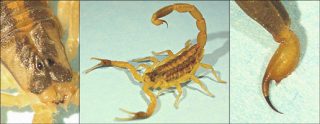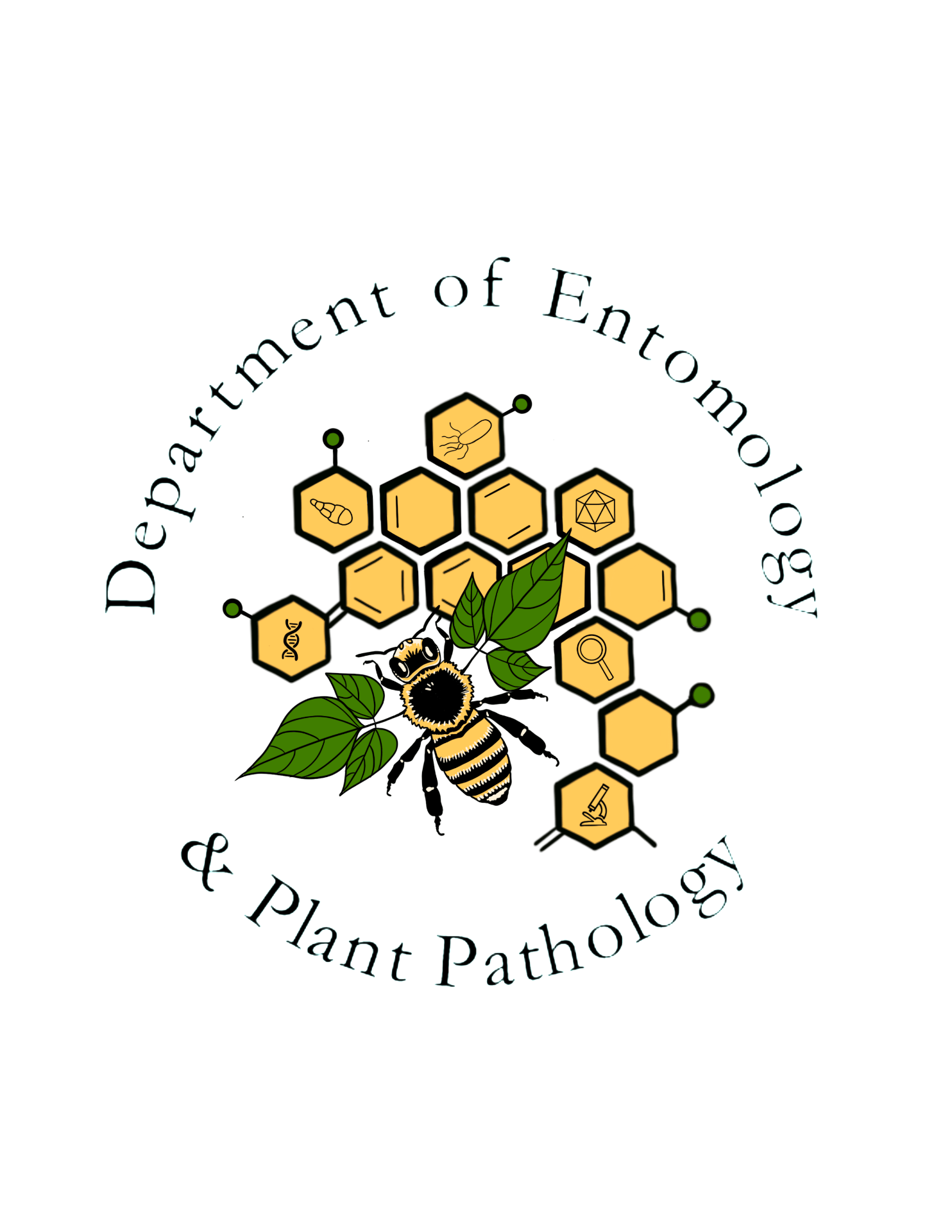Striped bark scorpion
Order: Scorpiones
Family: Buthidae
Genus and species: Centruroides vittatus (Say)

The only scorpion known to occur in Arkansas is the common striped bark scorpion, Centruroides vittatus. Adults are about 2 1/2″ long, and they have 2 broad, dark, longitudinal bands on the dorsal side of the body. The head region is darkly pigmented, with a well-defined, black triangle pointing backwards and extending just beyond the eyes. The appendages and the postabdomen are uniform yellowish brown, except for the tip of the stinger, which is black. A small tooth is present at the base of the slender, curved stinger. Striped bark scorpions glow phosphorescent yellow under ultraviolet light (Dorris 1971; Stahnke and Calos 1977).
This species is the most widespread scorpion in the United States. It occurs in the south-central and southwestern United States and in northern Mexico from Louisiana to New and from the Central Plains into the northern states of Mexico (Shelley 1994; Shelley and Sissom 1995). It occurs throughout Arkansas but is most abundant in the more western counties (Dorris 1971). It occurs in a wide variety of microhabitats in deserts, deciduous and pine forests, and grasslands. This scorpion can be found either on the ground or off the ground on trees, fence posts, or buildings, and individuals are often found indoors as well. They rest under loose bark or in depressions under rocks, logs, and other surface debris during the day, and they emerge after sunset. They frequently climb trees and other plants at night (Brown and O’Connell 2000).
Arkansas scorpions tend to roam considerably during April, May, and early June, and at that time they commonly enter houses. They apparently feed primarily on spiders, but locusts, moths, and caterpillars are also common prey. Cannibalism is common, at least in food-stressed populations from northwestern Arkansas. The gestation period is about 8 months. Litter size averages 31 young. Young scorpions cling to their mother’s back for 5 to 15 days. They require 3 to 4 years to mature (Baerg 1961; Ewing 1928; Polis 1990; Smith 1927; Yamashita 2004).
Around homes, striped bark scorpions are often found in woodpiles and crumbling foundations. They tend to cling to objects on the ground, and stings often occur when people turn over wood or rocks with bare hands. Usually the sting is of minor medical importance. The scorpion has venom glands in the bulbous structure at its posterior end. The glands are drained through ducts leading to a pore on the curved sting. The striped bark scorpion produces low toxicity venom that usually causes immediate sharp pain and local swelling after a sting. Pain soon subsides, and it may be followed by a local sensation of numbness or tingling, indicating nerve irritation. Chest tightness, nausea, vomiting, and dizziness may occur. The severity of the sting reaction varies with the sensitivity of the individual stung. Death and severe allergic reactions have been attributed to the striped bark scorpions, but such claims have never been substantiated by reputable sources (Baerg 1961; Demain and Goetz 1995; Ewing 1928; Keegan 1980).
References:
Baerg, W. J. 1961. Scorpions: biology an effect of their venom. University of Arkansas (Fayetteville) Agricultural Experiment Station Bulletin 649: 34 pages.
Brown, C. A., and D. J. O’Connell. 2000. Plant climbing behavior in the scorpion Centruroides vittatus. American Midland Naturalist 144: 406-418.
Demain, J. G., and D. W. Goetz. 1995. Immediate, late, and delayed skin test responses to Centruroides vittatus scorpion venom. Journal of Allergy and Clinical Immunology 95 (1): 135-137.
Dorris, P. R. 1971. Phosphorescent animal forms of Arkansas. Proceedings of the Arkansas Academy of Science 25: 69.
Ewing, H. H. 1928. The scorpions of the western part of the United States, with notes on those occurring in northern Mexico. Proceedings of the United States National Museum 73 (9): 24 pages.
Keegan, H. L. 1980. Scorpions of medical importance. University Press of Mississippi, Jackson. 140 pages.
Polis, G. A. 1990. The biology of scorpions. Stanford University Press, Stanford, California. 587 pages.
Shelley, R. M. 1994. Introductions of the scorpions Centruroides vittatus (Say) and C. hentzi (Banks) into North Carolina, with records of the indigenous scorpion, Vaejovis carolinianus (Beauvois) (Scorpionida: Buthidae, Vaejovidae). Brimleyana 21: 45-55.
Shelly, R. M., and W. D. Sissom. 1995. Distributions of the scorpions Centruroides vittatus (Say) and Centruroides hentzi (Banks) in the United States and Mexico (Scorpiones, Buthidae). Journal of Arachnology 23: 100-110.
Smith, F. R. 1927. Observations on scorpions. Science 65: 64.
Stahnke, H. L., and M. Calos. 1977. A key to the species of the genus Centruroides Marx (Scropionida: Buthidae). Entomological News 88: 111-120.
Yamashita, T. 2004. Surface activity, biomass, and phenology of the striped scorpion, Centruroides vittatus (Buthidae) in Arkansas, USA. Euscorpius 17: 25-33 (available at: http://www.science.marshall.edu/fet/euscorpius/pubs.htm).
Links:
• Oklahoma State University
• The Scorpion Files
• University of Michigan Museum of Zoology
• University of Missouri – Columbia
• University of Nebraska – Lincoln (images)
